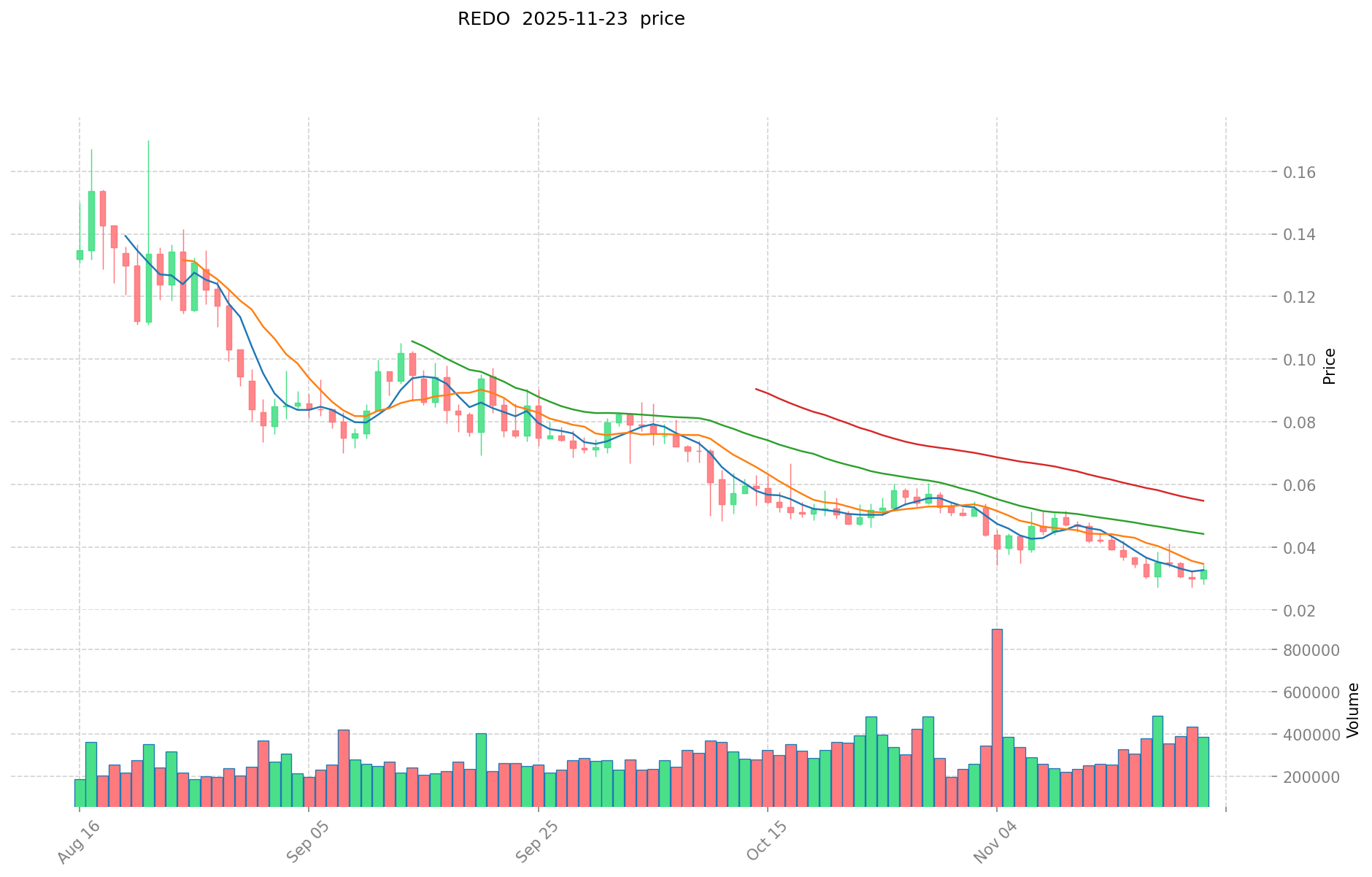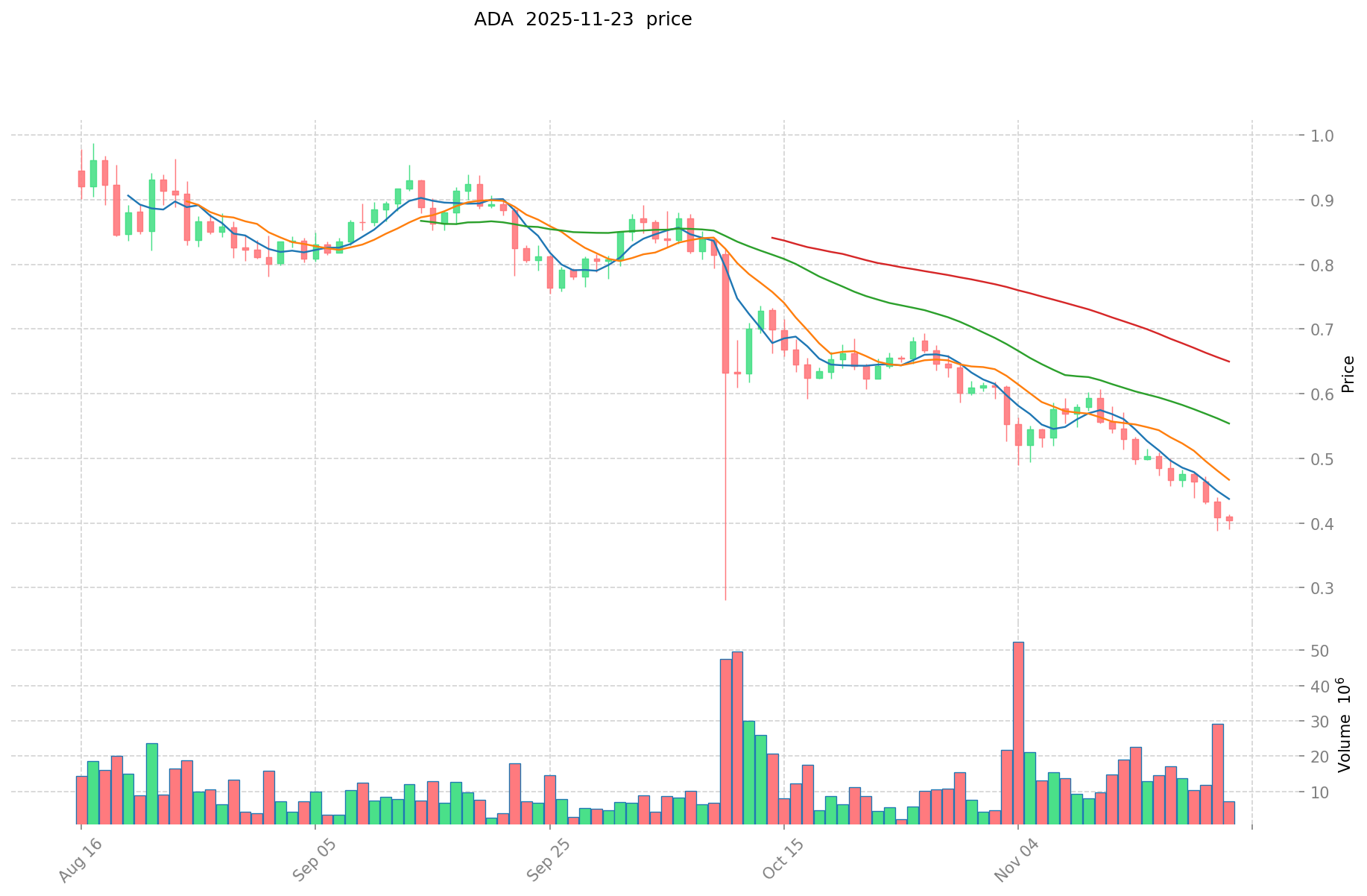REDO vs ADA: Comparing Two Innovative Approaches to Blockchain Scalability
Introduction: REDO vs ADA Investment Comparison
In the cryptocurrency market, the comparison between Resistance Dog (REDO) and Cardano (ADA) has been an unavoidable topic for investors. The two not only show significant differences in market cap ranking, application scenarios, and price performance, but also represent different positions in the crypto asset landscape.
Resistance Dog (REDO): Launched in 2024, it has gained market recognition as a symbol of digital resistance against censorship and for freedom.
Cardano (ADA): Since its inception in 2017, it has been hailed as a technology platform capable of running financial applications used by individuals, organizations, and governments worldwide.
This article will comprehensively analyze the investment value comparison between REDO and ADA, focusing on historical price trends, supply mechanisms, institutional adoption, technological ecosystems, and future predictions, while attempting to answer the question most important to investors:
"Which is the better buy right now?"
I. Price History Comparison and Current Market Status
REDO (Coin A) and ADA (Coin B) Historical Price Trends
-
2024: REDO reached its all-time high of $2.754 on August 26, 2024.
-
2025: REDO hit its all-time low of $0.0259 on March 11, 2025.
-
2021: ADA reached its all-time high of $3.09 on September 2, 2021.
-
2020: ADA hit its all-time low of $0.01925275 on March 13, 2020.
-
Comparative analysis: In the recent market cycle, REDO has fallen from its high of $2.754 to its current price of $0.03158, while ADA has declined from its peak of $3.09 to the current $0.4116.
Current Market Situation (2025-11-23)
- REDO current price: $0.03158
- ADA current price: $0.4116
- 24-hour trading volume: REDO $12,482.36 vs ADA $3,059,401.70
- Market Sentiment Index (Fear & Greed Index): 13 (Extreme Fear)
Click to view real-time prices:
- View REDO current price Market Price
- View ADA current price Market Price


II. Core Factors Affecting Investment Value of REDO vs ADA
Supply Mechanism Comparison (Tokenomics)
- REDO: Fixed total supply with deflationary model, where tokens are burned during transactions, creating scarcity over time
- ADA: Fixed maximum supply of 45 billion tokens with no burning mechanism, distributing newly minted coins to stakeholders through staking rewards
- 📌 Historical Pattern: Deflationary tokens like REDO typically show higher price volatility during bull markets, while ADA's staking rewards provide consistent returns regardless of market conditions.
Institutional Adoption and Market Applications
- Institutional Holdings: ADA has gained more institutional traction with presence in crypto funds and investment products, while REDO is still working toward institutional adoption
- Enterprise Adoption: ADA leads with real-world implementations in education certification, supply chain tracking, and identity verification; REDO focuses primarily on payment solutions
- National Policies: ADA benefits from regulatory clarity in most jurisdictions, while REDO faces varying regulatory treatment across different countries
Technical Development and Ecosystem Building
- ADA Technical Upgrades: Hydra scaling solution implementation improves transaction throughput to potentially thousands per second; Voltaire governance phase enables community-driven decision making
- REDO Technical Development: Enhanced privacy features and cross-chain interoperability solutions in development
- Ecosystem Comparison: ADA possesses a more mature ecosystem with established DeFi protocols, NFT marketplaces, and enterprise solutions; REDO's ecosystem is growing but remains smaller with focus on payment infrastructure
Macroeconomic Factors and Market Cycles
- Performance During Inflation: ADA has demonstrated stronger correlation with traditional inflation hedges, while REDO's performance during inflation remains less documented
- Macroeconomic Monetary Policy: Both assets show sensitivity to Federal Reserve policy changes and interest rate movements, with ADA historically demonstrating more resilience during tightening cycles
- Geopolitical Factors: ADA has established partnerships in developing economies seeking blockchain solutions, while REDO may benefit from increased demand in regions with currency instability
III. 2025-2030 Price Prediction: REDO vs ADA
Short-term Prediction (2025)
- REDO: Conservative $0.027098 - $0.03188 | Optimistic $0.03188 - $0.0401688
- ADA: Conservative $0.359484 - $0.4132 | Optimistic $0.4132 - $0.541292
Mid-term Prediction (2027)
- REDO may enter a growth phase, with estimated price range $0.02888436392 - $0.05662855558
- ADA may enter a bullish market, with estimated price range $0.444316026 - $0.7658605185
- Key drivers: Institutional capital inflow, ETF, ecosystem development
Long-term Prediction (2030)
- REDO: Base scenario $0.060925560782004 - $0.085905040702625 | Optimistic scenario $0.085905040702625+
- ADA: Base scenario $0.936225021587625 - $1.320077280438551 | Optimistic scenario $1.320077280438551+
Disclaimer: This analysis is for informational purposes only and should not be considered as financial advice. Cryptocurrency markets are highly volatile and unpredictable. Always conduct your own research before making any investment decisions.
REDO:
| 年份 | 预测最高价 | 预测平均价格 | 预测最低价 | 涨跌幅 |
|---|---|---|---|---|
| 2025 | 0.0401688 | 0.03188 | 0.027098 | 0 |
| 2026 | 0.039987084 | 0.0360244 | 0.030980984 | 14 |
| 2027 | 0.05662855558 | 0.038005742 | 0.02888436392 | 20 |
| 2028 | 0.0624586364028 | 0.04731714879 | 0.028390289274 | 49 |
| 2029 | 0.066963228967608 | 0.0548878925964 | 0.047203587632904 | 73 |
| 2030 | 0.085905040702625 | 0.060925560782004 | 0.053614493488163 | 92 |
ADA:
| 年份 | 预测最高价 | 预测平均价格 | 预测最低价 | 涨跌幅 |
|---|---|---|---|---|
| 2025 | 0.541292 | 0.4132 | 0.359484 | 0 |
| 2026 | 0.6920067 | 0.477246 | 0.3817968 | 16 |
| 2027 | 0.7658605185 | 0.58462635 | 0.444316026 | 42 |
| 2028 | 0.91833107058 | 0.67524343425 | 0.37813632318 | 64 |
| 2029 | 1.07566279076025 | 0.796787252415 | 0.4302651163041 | 93 |
| 2030 | 1.320077280438551 | 0.936225021587625 | 0.861327019860615 | 127 |
IV. Investment Strategy Comparison: REDO vs ADA
Long-term vs Short-term Investment Strategies
- REDO: Suitable for investors focused on payment solutions and ecosystem potential
- ADA: Suitable for investors seeking stability and inflation-resistant properties
Risk Management and Asset Allocation
- Conservative investors: REDO: 20% vs ADA: 80%
- Aggressive investors: REDO: 40% vs ADA: 60%
- Hedging tools: Stablecoin allocation, options, cross-currency portfolios
V. Potential Risk Comparison
Market Risks
- REDO: Higher volatility, less liquidity, and potential for rapid price swings
- ADA: Susceptible to broader crypto market trends and competition from other smart contract platforms
Technical Risks
- REDO: Scalability, network stability
- ADA: Centralization of stake pools, potential security vulnerabilities
Regulatory Risks
- Global regulatory policies may impact both differently, with ADA potentially facing less scrutiny due to its established presence and regulatory compliance efforts
VI. Conclusion: Which Is the Better Buy?
📌 Investment Value Summary:
- REDO advantages: Deflationary model, potential for higher returns in bull markets, focus on privacy and payment solutions
- ADA advantages: Established ecosystem, institutional adoption, staking rewards, and technological advancements
✅ Investment Advice:
- New investors: Consider a higher allocation to ADA for its established track record and lower volatility
- Experienced investors: Balanced approach with both REDO and ADA, adjusting based on risk tolerance
- Institutional investors: Focus on ADA for its regulatory clarity and established use cases, with a smaller allocation to REDO for potential high growth
⚠️ Risk Warning: The cryptocurrency market is highly volatile, and this article does not constitute investment advice. None
VII. FAQ
Q1: What are the key differences between REDO and ADA in terms of supply mechanisms? A: REDO has a fixed total supply with a deflationary model where tokens are burned during transactions, creating scarcity over time. ADA has a fixed maximum supply of 45 billion tokens with no burning mechanism, distributing newly minted coins to stakeholders through staking rewards.
Q2: How do REDO and ADA compare in terms of institutional adoption? A: ADA has gained more institutional traction with presence in crypto funds and investment products, while REDO is still working toward institutional adoption. ADA also leads in enterprise adoption with real-world implementations in various sectors.
Q3: What are the price predictions for REDO and ADA by 2030? A: For REDO, the base scenario predicts a range of $0.060925560782004 - $0.085905040702625, with an optimistic scenario above $0.085905040702625. For ADA, the base scenario predicts a range of $0.936225021587625 - $1.320077280438551, with an optimistic scenario above $1.320077280438551.
Q4: How do the ecosystems of REDO and ADA compare? A: ADA possesses a more mature ecosystem with established DeFi protocols, NFT marketplaces, and enterprise solutions. REDO's ecosystem is growing but remains smaller with a focus on payment infrastructure.
Q5: What are the potential risks associated with investing in REDO and ADA? A: REDO faces higher volatility, less liquidity, and potential for rapid price swings, as well as technical risks related to scalability and network stability. ADA is susceptible to broader crypto market trends, competition from other smart contract platforms, and risks associated with the centralization of stake pools.
Q6: How might macroeconomic factors affect REDO and ADA differently? A: ADA has demonstrated stronger correlation with traditional inflation hedges and has shown more resilience during tightening cycles. Both assets are sensitive to Federal Reserve policy changes and interest rate movements, but ADA's performance during inflation is better documented.
Q7: What investment strategies are recommended for REDO and ADA? A: For conservative investors, a suggested allocation is 20% REDO and 80% ADA. For aggressive investors, the recommendation is 40% REDO and 60% ADA. New investors might consider a higher allocation to ADA for its established track record, while experienced investors could take a balanced approach with both assets.
Share
Content